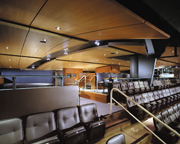
That was the situation my company, T-P Acoustics Inc., faced during the recent renovation of America West Arena, the home of the Phoenix Suns NBA basketball team. We were hired to work with the construction manager and design team to remodel the interior public spaces. This work included the Arena's VIP club, to be renamed the Platinum Club, which featured plush seating, lounge and dining areas, and all the amenities.
Slam dunk
The design called for a complex, curved and splayed wood ceiling that would curl up the back wall, flow along the contours of the concrete structure above, and swoop down to direct a spectator's attention towards the arena floor below. The specifications called for wood veneer on particle board shaped to curved wood frames. When we priced the system, however, we realized it exceeded the project's budget by 25 percent and added eight weeks to the already tight completion schedule.Instead of using real wood, we decided on Sarante manufactured by Ceilings Plus, a wood-grained, architectural-grade finish that could be laminated to a metal panel for less than the cost of natural veneers. Since it was new, the product had never been used for a major ceiling project. I was concerned about how the product would look and about its ability to withstand damage during installation and occupancy. I was pleasantly surprised.
The panels looked fine, have proved to be tough and durable, and they resulted in several additional benefits. The product's finish is consistent in its appearance, and has uniform wood graining throughout the job. With natural wood, one can sometimes have light and dark piece of veneer that requires extra attention to make sure the panels are laid out in an attractive way. With this finish, the last piece installed looked just as good as the first. Standing on the floor looking up at the ceiling, you can't tell it's not the real thing.
I was concerned that the product would scratch easily and would be difficult to repair. But it went through severe tests on this project and came out fine. For example, the ceiling had to be accessed on several occasions to complete overhead work. If we had used wood, there could have been lots of damage. I would say it was even more resistant to damage than a painted panel or exposed metal finish-scratches that can be seen in a plain panel are practically invisible with this product. And unlike wood, it was easy to clean with mild soap and water.
Similarly, real veneer would have had to be brought into the building a week in advance to stabilize to the environment. But we had to work in spaces that were not controlled for temperature or humidity. In fact, the Arena floor was being flooded for an ice skating rink while we were putting in the ceiling. The product was 100 percent stable under all conditions.
Hot stuff
At the other end of the temperature range, there were concerns about the heat from recessed halogen lights in the ceiling. The product's been installed for more than four months now and the lights are on almost continuously. And there is no failure or distress caused by the lighting. Plus, the material has a Class A rating for surface burning characteristics, so there was no problem using it in a place of assembly like the Arena.The Sarant¿as factory applied on aluminum panels that weighed far less than the originally specified wood panels. This enabled us to use a lighter-duty suspension system. And even though the typical panels were 4-feet-by-8-feet in size, it took just two men to install a panel, so we were able to use a smaller crew.
We were able to give our client several benefits that would not have been readily available with the original wood system. For example, the manufacturer can use its automated perforating equipment on a finished panel. This made it affordable for us to provide perforated panels and acoustical insulation in a few rooms where the Platinum Club wanted quieter spaces. And probably the single biggest advantage of the Radians panels utilized is that every panel is accessible-a real plus for the owner for accessing all the mechanical and electrical equipment on the job.
Everybody is really pleased with how well the Platinum Club job turned out. In fact, it was the Runner-Up in this year's CISCA ceiling competition. And in our business, that's as good as winning a berth in the NBA Playoffs. W&C
